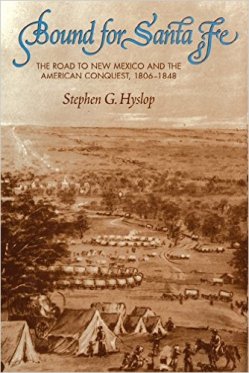 Bound for Santa Fe: The Road to New Mexico and the American Conquest, 1806-1848. By Stephen G. Hyslop. (Norman: University of Oklahoma Press, 2002. Xiii + 514 pp. Illustrations, notes, bibliography, index. $34.95.)
Bound for Santa Fe: The Road to New Mexico and the American Conquest, 1806-1848. By Stephen G. Hyslop. (Norman: University of Oklahoma Press, 2002. Xiii + 514 pp. Illustrations, notes, bibliography, index. $34.95.)
Once in a while a book attains benchmark status in the historiography of a particular subject. Bound for Santa Fe, by Stephen G. Hyslop, has done so. Its palate is sweeping, and the author’s handling of the story both complex and captivating. More than any other recent work of history on the Santa Fe trail and trade, it captures the essence of the story and relates it to an audience removed from it by more than 200 years. Most of all, Bound for Santa Fe is an exceptionally well-written work of history, tantalizing in its depictions and seductive in the power of its narrative.
Beginning with the earliest exploring parties from the United States into the Southwest, Hyslop takes the reader through the origins and development of the Santa Fe trade, using narratives from the trail as the centerpiece of a journey from Missouri to New Mexico. Along the trail readers meet the native peoples who had made the region their homes for centuries, the Santa Fe culture and its sometimes uneasy coexistence with Anglos from Missouri, and the unique world these various cultures made through their interactions.
At the same time, the interactions proved surprising to both sides. As only one example, Missourians expressed dismay at the mores of the New Mexicans, and that cultural divide never seemed to end despite years of close contact. When trader John Scolly hauled his Latina wife, Juana Lopes, before a Mexican judge for adultery the outcome was remarkably different to what Scolly had expected. Lopes did not deny the charges, instead offering the belligerent explanation, as reported in the court record, that “it was her ass, she controlled it, and she would give it to whomever she wanted” (p. 266). The judge told her to quit “roving” and stay with her family but stopped short of punishing her, as would have undoubtedly been the case in the U.S. Such cultural differences sprinkle this work, demonstrating the oddity and attraction of these two civilizations.
Hyslop completes his work with a discussion of American conquest of New Mexico in 1846-1848. He follows the path of the Army of the West under Stephen Watts Kearny, the experience of Alexander Doniphan and Sterling Price and their Missouri volunteers, the creation of a territorial government under Charles Bent, and the bloody Taos revolt.
In 1979 John D. Unruh Jr. published The Plains Across: The Overland Emigrants and the Trans-Mississippi West, 1840-60 (University of Illinois Press), unraveling the complex story of the overlanders on America’s longest trail. Hyslop offers a work very similar to Unruh’s in style and substance for the Santa Fe trail, and it may become a standard on the subject for many years.

